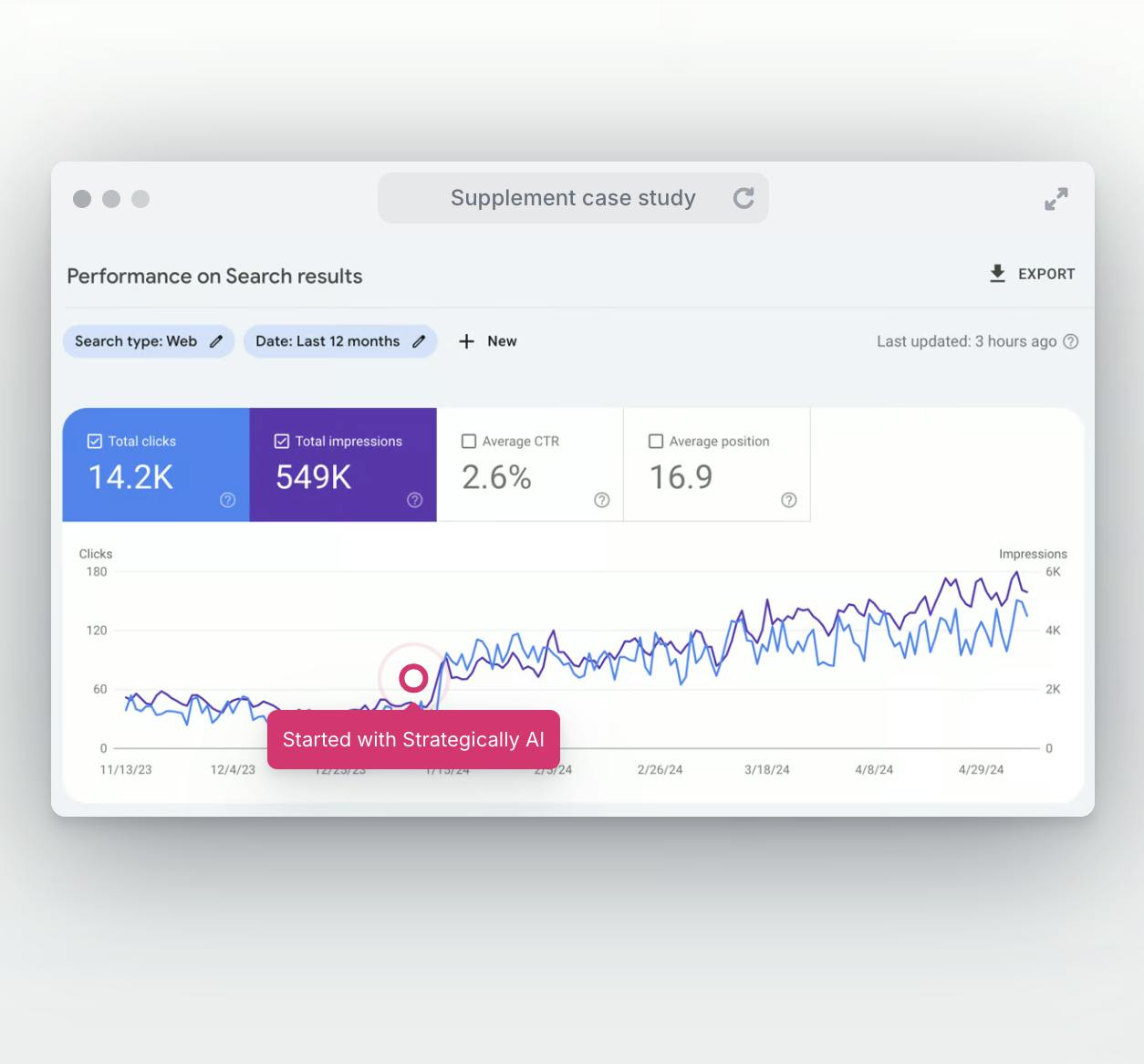An anchor text provides important web page context for Google and the user.
In this guide, we've shared everything you should know about anchor texts, including what they are, why they matter, and how to write a good anchor text.
Key Takeaways:
- An anchor text is the clickable text that you attach a hyperlink to.
- For example, if you wanted to link to a related article or product on your website or elsewhere on the internet, you would attach the link to this article to an anchor text.
- A good anchor text should be concise and descriptive, and should include relevant keywords.

What is an anchor text? Quick definition
An anchor text is the text that you use to hyperlink to another part of the internet.
Anchor texts are clickable texts that are dark blue and sometimes underlined. When users see an anchor text, they know that clicking on it will take them to the article or product that's being mentioned in the anchor text.
A well-written anchor text should be relevant to the product or article that the text is linking to. Search engines use the keywords in the anchor text to help determine a web page's topic.
Anchor text examples
If you've never noticed an anchor text before or you just want some examples, we've shared a few below.
Example 1: Let's say you're writing an article titled "The best dry food for senior dogs". You want to share a link to your top recommended dog food. The anchor text for this link would be something like: "our top recommended senior dog food", with "senior dog food" being the target keyword.
Example 2: Let's say you're writing an article called "What is the smartest dog breed?" and you want to share a link to another article on your website called "A definitive guide to all the dog breeds found today". The anchor text for this link would be something like: "our guide to the different dog breeds", with "dog breeds" being the target keyword.
Different types of anchor texts
Let's take a look at the most common types of anchor texts you're likely to use in your SEO strategy.
Exact match anchor text
Exact match anchor text uses a keyword combination that's identical to the keywords used in the page that's being linked to - or at least contains the primary keyword from the page title.
For example, when linking to an article titled "best refrigerators for small kitchens", in an exact match anchor text, the linking text would be the same.
It's okay to use exact match anchor texts here and there, but keep in mind that too many anchor texts of this kind can be a red flag in Google's eyes.
If you use exact match anchor text too often, Google might find it harder to determine the page structure, reducing your ranking potential for the target keyword.
Partial match anchor text
Partial match anchor text uses a keyword that's similar to, but not the same as, the keyword on the linked-to webpage.
So, if you linked to a video titled "how to optimize your anchor text", a partial match anchor text might read: "best methods of anchor text optimization" (with "anchor text" being the target keyword).
Related keyword anchor text
Similar to partial match anchor text is related keyword anchor text. The difference is that related keyword anchor text uses a keyword that's related to the main keyword - but isn't identical.
As an example, if you linked to a video titled "how to optimize your anchor text", a related keyword anchor text might read: "link text strategies" (with "link text" being the related keyword to "anchor text").
Branded anchor text
Branded anchor texts are anchors that have a brand as the main keyword. This type of anchor text is a good option if you're linking to a credible source in your industry or citing another website for a quote or statistic.
For example, if you're linking to Hubspot for a useful piece of content marketing statistics, the anchor text would simply be "Hubspot".
Brand & keyword anchor text
Branded anchor text might not always say exactly what you want to say about a link. In this case, you'll probably benefit from using a brand and keyword anchor text, which combines a brand name with a keyword that gives additional context.
So, using the same Hubspot example as above, you could expand on your branded anchor text to say: "Hubspot's latest content marketing statistics".
Naked anchor text
Naked anchor text is when you don't blend the anchor text into the surrounding text - instead, you use the link's URL. This looks unusual in the middle of a sentence, so a naked link is usually included at the bottom of an article in a list of sources.
You should only use a naked link anchor text if no other types of anchor text make better sense.
Generic anchor text
Generic anchor text is our least recommended anchor text type to use. This type of link anchor text is usually not specific to the page you're linking to.
Examples of generic anchor text are "click here", "view more", and "this article".
If you do decide to use generic anchor text, use it sparingly to avoid coming across as spammy.
Image alt texts
Image alt text is technically a type of anchor text. If the image fails to load, the anchor text will display in the image's place.
This can be useful because it still gives some context to the image, even if it can't be viewed by the user.
Image anchor text should be exactly the same as anchor text in your written content: it needs to accurately and concisely convey the subject of the image, and you should use a variety of anchor text variations for your images.
Why is anchor text important?
Using anchor texts might look nicer than simply dropping a URL in the middle of your article - but why exactly is anchor text important for SEO?
A well-written anchor text does two things:
- It enhances the user's experience on Google
- It helps your website to rank
User experience and ranking are intrinsically linked because one of Google's main priorities is to provide value to its users.
When anchor texts are relevant, they help Google to understand the structure of your website.
For example, if an anchor text is "top 5 cupcake recipes", it tells Google that the page being linked to is about the best cupcake recipes.
It's easy to see from this example how generic anchor text is, on the other hand, unhelpful. A generic phrase like "click here" will have no SEO purpose because it doesn't tell Google anything about the site you're linking to - even if the surrounding text does.
So, think carefully about the anchor texts you use when building links as part of your SEO strategy.
What makes a good anchor text?
Now we know some examples of anchor texts, what makes a good anchor text?
A good anchor text should have the following features:
- It should be descriptive of the page it's linking to. Make sure the anchor text succinctly explains where it's sending the reader. It goes without saying that the anchor text should only be relevant to the article it's linking to.
- It should ideally be more than one word. The word "here" or even "click here" isn't enough to describe to Google what you're linking to. Imagine that the rest of the sentence was taken away. Without this for context, it should still make sense what your anchor text is linking to.
- It should contain appropriate keywords. Ideally, your anchor text should contain at least one of the main keywords used in the web page you're linking to.
- It shouldn't be identical to other anchor texts on your web pages. It's important to vary your anchor text usage to avoid looking spammy to Google.
- It should entice a click. Linking to other parts of your website is good for SEO, but that's not all. You should also aim to entice readers to actually click on the link and read your next article or visit your product page, extending their browsing time on your website.
- It should be natural. Avoid keyword stuffing - it'll put your content at risk of flagging as spam.
- It should send readers to a variety of web pages. If you excessively link to the same article or product page in your articles, you might raise suspicions with Google.
- It should be easy to spot. Some websites disguise links in their text by formatting the anchor text to look exactly the same as the rest of the article text. This seems suspicious and prevents readers from knowing when you might be linking to a useful source.
What does Google want to see in an anchor text?
Don't just take our word for it - the team at Google has produced an anchor text style guide that outlines what the search engine expects from anchor text formatting, usage, and more.
A few important points from this guide are:
- Your anchor text should be a descriptive phrase that gives context to what you're linking to.
- A good anchor text is either an exact keyword match to the title of the web page you're linking to, or it's a description of the destination web page, included naturally as part of the sentence.
- You shouldn't over-use exact keyword match anchor texts as they look spammy and may be penalized by Google.
- The anchor text should be unique and descriptive, and should make sense within the rest of the sentence.
- You can introduce readers to the destination page with "for more information about XXX, see..."
- Avoid using generic terms like "click here" or "this article". The anchor text should be more specific to the article or page you're linking to.
- Don't use the URL itself as the link text. This looks out of place in a sentence. Instead, choose a suitable piece of descriptive text that fits naturally in your article.
- Avoid reusing the same link text within the same article to link to several different web pages.
- Keep the link text shorter than a sentence whenever possible. Avoid linking large chunks of text, like a paragraph.
- Try to avoid using punctuation within the link tag.
That's a lot of valuable information to remember. Note down anything you think you'll forget and keep it close by when you come to add anchor texts to your article.
Can anyone write an anchor text?
Yes, anyone can write a good anchor text. As long as you follow the steps in this guide, you can write your own anchor texts so that readers and search engines understand what you're linking to.
However, you'll need to do your research and develop a good anchor text strategy to avoid coming across as spammy on search engines.
You can write an anchor text if:
- You have the time and the patience to learn everything you need to know to write good anchor texts.
- You use everything you've learned from your research when adding links and anchor texts to your articles.
- You have a good understanding of the best anchor texts to use within your particular niche or industry.
- You're prepared to keep up-to-date with anchor text SEO, and you know the importance of implementing new strategies to produce new anchor texts and optimize existing anchor texts based on Google updates.
You probably shouldn't spend time writing anchor texts if:
- You're too busy with other areas of your business and you don't have time to learn anchor text strategy and keep up with Google updates in this area of SEO
- You admit that your SEO knowledge is lacking and you think an expert could produce anchor tests for your articles much faster and more efficiently.
In short, anyone can write an anchor text if they're willing to learn about the types of anchor text, what Google expects from anchor texts, and how to master anchor text SEO.
But if you've got enough on your plate and writing SEO articles with properly-written anchor texts is too much work to take on, consider hiring an expert SEO copywriter who can take the task off your hands.
How to write a good anchor text: step by step process
We already know a lot about what you should and shouldn't include in an anchor text.
So, the next step is to use what you've learned to write your own.
Here's an easy step-by-step process for writing a good anchor text:
Step 1: Establish the webpage you want to link to
Your first step is to find the webpage that you want to link to.
You might be working on your internal site linking strategy and have a list of links to include at various points in your articles.
In this case, read through your articles and work out where it makes sense to include one of your links. You may need to add a new sentence or amend a current sentence to naturally include the link and anchor text.
Or, you might be writing an article and researching as you go. If you reach a point that could be expanded on with additional data, extra reading, or a statistic, find a suitable webpage on Google.
Step 2: Write your anchor text
Now you know exactly what you're linking to and in which part of your article, you can write the anchor text.
Remember everything we've outlined above: the anchor text should ideally be short, and either an exact match to the title of the page you're linking to, or a description of the linked page.
Step 3: Read and revise
Read your anchor text and ask yourself the following:
- Does it make sense within the sentence?
- Does it include relevant keywords that relate to the main topic of the linked page?
- Is it the right length? Try and aim as close to 5 words as possible.
- Is it specific to the linked page and not too generic?
Try changing a few words here and there and see if it makes a difference to how the sentence reads.
Step 4: Add the link
Once you've perfected the anchor text, you're ready to add the link.
Make sure the link is the best you can find for what you're discussing in the sentence. When you're linking externally, some links will be more relevant and offer clearer information than others.
Usually, you can't go wrong with linking to one of the top-performing articles on Google, since these are taking the top spots for a reason.
This might seem like a lot of steps for half a sentence of text, but it's a good way to practice writing the best anchor texts until it becomes second nature to you and you don't need to follow a structure.
Can you over-optimize anchor text?
Yes, it's possible to over-optimize your anchor text.
If you use too many exact match anchor texts, Google may view these negatively. That's why it's recommended to use a variety of types of anchor text, and to use natural language in and around your text as much as possible.
You can't go wrong if you work out the quickest, clearest, and most succinct way to describe the linked page.
Also make sure that you don't link at every opportunity - that will look excessive and spammy.
It's better to produce your content first, making sure it's as valuable and helpful as possible, and meets the user's search intent.
Once you've achieved this, you can go back through your article and look at ways to naturally add links within the text.
Only add links where it makes sense. This could mean amending some of your existing content.
Final Word
Once you know the basics of writing anchor text, you're good to go.
Anchor texts are only a few words long and they're not particularly difficult to get to grips with, so you should be able to use them effectively within your SEO strategy.
Remember, though, that anchor text is only one small piece of the puzzle. If your goal is to boost your search engine rankings, you should also make sure to optimize your articles with an SEO-friendly title and structure, effective keyword placement, consistent posting, and tagged images.
Readers don't only look at the anchor text when they're deciding whether or not to follow a link. So, the words surrounding the anchor text should make sense and help users to better understand how they will get extra value from clicking on your link.
Don't forget the other ranking factors, too, such as optimizing your content for featured snippets, ensuring your pages are relevant and usable, and implementing a content delivery strategy that proves to Google that you're an expert in your industry.
There's a lot that goes into an effective content strategy, and many businesses find it easier to outsource the job to an experienced content writing company. But if you're keen to manage your own content, learning how to write optimized anchor text is a great place to start.
Anchor texts FAQ
How many anchor texts are best in a single article?
There's no set rule for how many links - and therefore how many anchor texts - a single article should contain. There are a few factors that affect the number of links you should include in your article, including the article's word count. Try to aim for at least 3-4 external links per 1,000 words, but avoid too many links, which looks spammy.
How do I create an anchor text?
To create an anchor text, identify the page that you want to link to, then find a way to concisely and naturally describe the topic of the page in around 5 words, so that the reader understands exactly what to expect if they click on your link.
How do you add anchor text to an article?
It's easy to add anchor text to an article and you don't need to learn how to code. Simply write your content, then highlight the words that you want to add a link to, and click the link icon in the formatting bar. Paste or type your link into the space that appears, then click "enter" or "confirm". You can amend your anchor text at any time by clicking anywhere in the text. Deleting and rewriting parts of the text won't affect the link.
Does anchor text affect SEO?
Yes, anchor text affects SEO since it tells Google what the linked page is about. Anchor text is one of Google's page ranking factors, so a poorly-written anchor text (or failing to use an anchor text at all when sharing links) may work against you in the SERPs.
What should you not do with anchor text?
A few things that you shouldn't do with anchor text are:
- Don't use generic terms like "click here" or "this article", which don't describe to the reader what you've linked to.
- Don't be too wordy. Try to stick to around 5 words where possible.
- Don't use information that’s misleading to the reader. The anchor text should accurately describe the content in the linked page.
- Don't use the URL as the link text - it's better to use descriptive keywords.
Is anchor text a hyperlink?
Yes, anchor text is a hyperlink - it's the piece of text that's hyperlinked to a webpage. Anchor text is usually a short piece of text that explains what the hyperlink is linking to. It's rare for a URL (the actual web link) to be used as anchor text.








